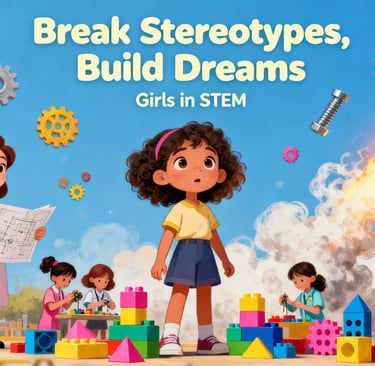
Debbie Sterling
How GoldieBlox to Get Girls into Engineering
Shane Brown
11/12/20254 min read


How Debbie Sterling Built GoldieBlox to Get Girls Into Engineering
Girls start losing interest in math and science around age six. Not because they lack ability. Because of culture.
Debbie Sterling saw this problem firsthand. She graduated from Stanford with a mechanical engineering degree in 2005. Throughout her program, she was surrounded by male classmates. The boys had grown up building things with construction toys. Sterling never did. She noticed the pattern. Boys got tools and blocks. Girls got dolls and princesses.
This gender gap in childhood toys matters. Research shows kids who play with spatial toys develop better problem-solving skills. They're more likely to pursue STEM careers. For decades, these toys were marketed exclusively to boys. Girls were left out.
Sterling decided to change this. In 2012, she quit her job and launched GoldieBlox.
Finding Her Mission
On graduation day at Stanford, Steve Jobs told graduates to never settle until they found their passion. Sterling took those words seriously. She spent years exploring different paths. She worked at a branding agency in Seattle. She volunteered at a nonprofit in India. She became marketing director for a jewelry company in San Francisco.
Nothing felt right.
Then during a monthly brunch with fellow female engineers, someone mentioned how playing with construction toys as a kid sparked their interest in engineering. Sterling had her answer. She would create engineering toys specifically designed for girls.
Facing Industry Rejection
Sterling developed prototypes and brought them to the International Toy Fair in New York City. The response was brutal.
"Girls want princesses," toy executives told her. "Boys like building and girls like dolls. You can't fight nature."
The rejection revealed how deeply gender stereotypes run in the toy industry. Walk into any toy store and you'll see it. Pink aisles full of dolls and beauty products. Blue aisles packed with building sets and science kits. This division creates a self-fulfilling prophecy. Girls don't get exposure to construction toys. They don't develop spatial skills. They're less likely to pursue engineering.
Sterling knew the toy industry had this backwards. The problem wasn't nature. The problem was culture.
The Kickstarter Breakthrough
When traditional toy companies rejected her, Sterling went directly to consumers. She launched a Kickstarter campaign in 2012 with a prototype toy set and handmade book featuring Goldie Blox, the world's first girl engineer character.
The campaign exploded. She reached her $150,000 goal in four days. By the end, she raised $285,881 from 5,519 backers. Within six months, GoldieBlox toys hit shelves at Toys "R" Us. Within the first month, the company received over $1 million in pre-orders.
Parents wanted these toys. Educators wanted these toys. The market existed. The toy industry had simply refused to see it.
The GoldieBlox Formula
Sterling made GoldieBlox different by combining construction with storytelling. Girls typically have strong verbal skills. Sterling used this strength as a bridge to spatial learning. Each toy set comes with a book telling Goldie's story. Kids read about problems Goldie faces. Then they build machines to help solve those problems.
The approach works. A study at a girls' school tracked second and third graders using GoldieBlox for one year. Results showed significant increases in key areas. Students were more willing to take things apart. They planned better when building projects. They approached problems with more structure.
Sterling later introduced Ruby Rails, an African-American coder character. She worked for two years to create an action figure with authentic features. This representation matters. Studies show girls are 33% more likely to consider STEM careers when they see women in those fields.
Going National
In 2014, GoldieBlox won a contest for a Super Bowl commercial spot worth $4 million. The ad showed girls building a rocket ship from toys. GoldieBlox became the first small business ever to advertise during the Super Bowl.
That same year, they debuted a float at the Macy's Thanksgiving Day Parade. The massive float featured oversized GoldieBlox pieces powered by kids pedaling and cranking. They returned to the parade in 2015.
These appearances sparked national conversations about gender stereotypes in toys. Major retailers like Target and Amazon removed gender-specific labeling from toy departments.
Recognition and Awards
Sterling's work earned serious recognition. TIME Magazine named her "Person of the Moment." Business Insider listed her among "30 Women Who Are Changing the World." Fortune Magazine put her on their "40 Under 40" list. Fast Company named GoldieBlox one of the "World's Most Innovative Companies" in 2014.
President Obama inducted Sterling as a Presidential Ambassador for Global Entrepreneurship in 2015. The National Women's History Museum honored her with a "Living Legacy" Award. The Toy Industry Association gave GoldieBlox the 2014 Educational Toy of the Year award.
Expanding the Brand
GoldieBlox grew beyond toys into a multimedia company. They launched YouTube series teaching kids to build projects with STEM concepts. These channels attracted over 200,000 subscribers in six months. Videos have now reached over 100 million views with 660,000 subscribers.
Sterling partnered with Random House to publish chapter books. She created apps teaching girls to code and animate. These apps have been downloaded more than 1.5 million times. GoldieBlox worked with Girl Scouts to develop STEM engineering badges.
By 2016, GoldieBlox had sold more than 1 million toys through more than 6,000 retailers worldwide. The company recently partnered with Black Girls Code for a free coding academy aimed at girls ages 7-10.
Why This Matters
When GoldieBlox launched in 2012, only 11% of engineers in the United States were women. Women represented about 13% of the engineering workforce globally. Studies showed gender stereotypes about STEM form by age six. Kids already associate boys with greater aptitude in science and engineering.
This early bias creates a pipeline problem. Girls who believe STEM "isn't for them" at age six make decisions about high school classes, college majors, and careers based on this belief. The gap perpetuates itself.
Even today, progress remains slow. Women comprise only 15% of engineers in the United States. In mechanical engineering specifically, women make up less than 9% of the workforce. Globally, women represent only 28% of the STEM workforce.
The Impact
Sterling proved every industry expert wrong. They said construction toys for girls would never sell. She built a multimillion-dollar company. They said girls naturally prefer dolls. She showed the preferences were cultural, not biological.
GoldieBlox has reached billions of consumers through television, radio, and digital media. Millions of girls now play with toys showing them they're capable of building, inventing, and engineering.
The girls who first played with GoldieBlox in 2012 are teenagers now. They're making decisions about their futures. Some will become engineers. Some will become programmers. Some will invent things we haven't imagined yet.
Sterling built more than a toy company. She built a tool for changing culture. One building block at a time.
